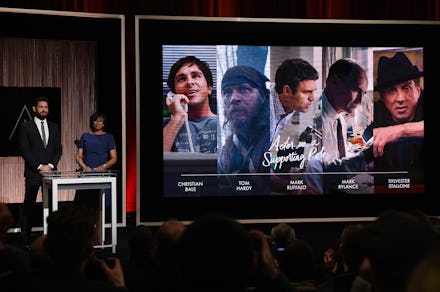This 10-Year Report on Oscar Nominations Looks Dismal for Women Behind the Camera

The demand for a more representative entertainment industry has undeniably reached a fever pitch. Creators and consumers have skewered Hollywood's inability to represent and reflect the diverse experiences of many viewers. But new research demonstrates that such discrimination isn't just about who is excluded from the screen, but also who is behind the camera — and even more specifically, who isn't being recognized by one of the industry's highest honors: the Oscars.
Here's what new research from the Women's Media Center reveals: Women have received only 19% of Oscar nominations in nonacting categories over the past decade. Female nominees only composed 13% of total nominations for writing, 17% for film editing and 24% for producing.
Read more: How Many of the Best Picture Nominees From the Last Ten Years Pass the DuVernay Test?
What's more, men particularly dominated categories that reflect roles requiring great decision-making power. None of the nominees in the cinematography category have been women, not just in the last decade, but the awards' entire 88-year history. And only one woman has ever won the award for best director.
This issue has persisted beneath the surface of the industry at large for years, according to the president of the Women's Media Center, Julie Burton.
"These nomination numbers reflect overall employment numbers in the industry," Burton told Mic. "If women cannot get through the door in the first place, they cannot be nominated and celebrated for their excellence. Nor can they benefit from the career advantages that come with Academy Award nominations. These numbers are staggering and reflect the need for the Academy — and the industry it represents — to change the status quo and open the doors to women and people of color. It is a win-win opportunity to expand the audience and storytelling to actually look and sound like America."
The facts bolster Burton's claim. A mere 27% of primetime TV creators, writers, producers, executive producers, photography directors and editors were female between 2013 and 2014, according to a 2015 Women's Media Center report, and just 7% of the top 250 grossing films in 2014 were directed by women, according to a San Diego State University report.
Award-winning writer and director Amma Asante said that the awards are just part of the problem.
"Most often, it's the lack of opportunity available to women, and it's especially hard if you are a woman of color," Asante said a statement. "It's important to change the narrative for little girls so that they can picture themselves in the director's chair — a position of strength, power and prestige."
This refusal to diversify is not only detrimental to viewers or women working in the industry, but also to the very industry itself. A 2015 UCLA study revealed that diverse films earned the most money worldwide and delivered the highest median investments, while diverse TV shows were the most popular among viewers aged 18-49, Women and Hollywood reported.
"There's no lack of talent or stories or films to celebrate," chair of the Sundance Institute and WMC board co-chair Pat Mitchell succinctly summarized in a statement. "What there is a lack of is the commitment, the vision to see beyond what Hollywood chooses to celebrate as representative and the best."